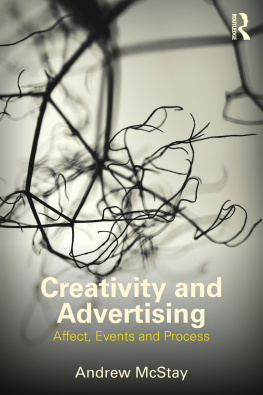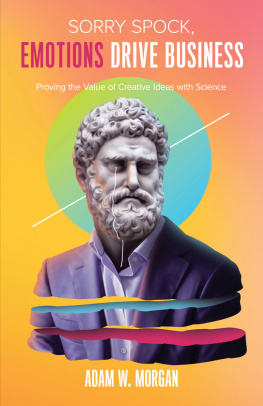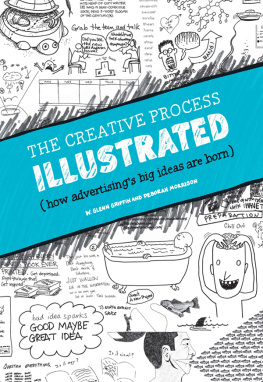A Technique for Producing Ideas
A Technique for Producing Ideas
A McGRAW-HILL Advertising Classic
JAMES WEBB YOUNG


Copyright 2003 by The McGraw-Hill Companies, Inc. All rights reserved. Printed in the United States of America. Except as permitted under the United States Copyright Act of 1976, no part of this publication may be reproduced or distributed in any form or by any means, or stored in a database or retrieval system, without the prior written permission of the publisher.
ISBN: 978-0-07-142625-1
MHID: 0-07-142625-6
The material in this eBook also appears in the print version of this title: ISBN: 978-0-07-141094-6, MHID: 0-07-141094-5.
All trademarks are trademarks of their respective owners. Rather than put a trademark symbol after every occurrence of a trademarked name, we use names in an editorial fashion only, and to the benefit of the trademark owner, with no intention of infringement of the trademark. Where such designations appear in this book, they have been printed with initial caps.
McGraw-Hill eBooks are available at special quantity discounts to use as premiums and sales promotions, or for use in corporate training programs. To contact a representative please e-mail us at bulksales@mcgraw-hill.com.
TERMS OF USE
This is a copyrighted work and The McGraw-Hill Companies, Inc. (McGraw-Hill) and its licensors reserve all rights in and to the work. Use of this work is subject to these terms. Except as permitted under the Copyright Act of 1976 and the right to store and retrieve one copy of the work, you may not decompile, disassemble, reverse engineer, reproduce, modify, create derivative works based upon, transmit, distribute, disseminate, sell, publish or sublicense the work or any part of it without McGraw-Hills prior consent. You may use the work for your own noncommercial and personal use; any other use of the work is strictly prohibited. Your right to use the work may be terminated if you fail to comply with these terms.
THE WORK IS PROVIDED AS IS. McGRAW-HILL AND ITS LICENSORS MAKE NO GUARANTEES OR WARRANTIES AS TO THE ACCURACY, ADEQUACY OR COMPLETENESS OF OR RESULTS TO BE OBTAINED FROM USING THE WORK, INCLUDING ANY INFORMATION THAT CAN BE ACCESSED THROUGH THE WORK VIA HYPERLINK OR OTHERWISE, AND EXPRESSLY DISCLAIM ANY WARRANTY, EXPRESS OR IMPLIED, INCLUDING BUT NOT LIMITED TO IMPLIED WARRANTIES OF MERCHANTABILITY OR FITNESS FOR A PARTICULAR PURPOSE. McGraw-Hill and its licensors do not warrant or guarantee that the functions contained in the work will meet your requirements or that its operation will be uninterrupted or error free. Neither McGraw-Hill nor its licensors shall be liable to you or anyone else for any inaccuracy, error or omission, regardless of cause, in the work or for any damages resulting there from. McGraw-Hill has no responsibility for the content of any information accessed through the work. Under no circumstances shall McGraw-Hill and/or its licensors be liable for any indirect, incidental, special, punitive, consequential or similar damages that result from the use of or inability to use the work, even if any of them has been advised of the possibility of such damages. This limitation of liability shall apply to any claim or cause whatsoever whether such claim or cause arises in contract, tort or otherwise.
Contents
Foreword
By Keith Reinhard, Chairman, DDB Worldwide
How can a book first published in the 1940s be important to creative people on todays cutting edge? By answering the question that inspired James Webb Young to write this remarkable little volume in the first place: How do you get ideas? The blank page or screen that awaits a transforming idea today is just as intimidating as ever. Maybe more so, because our advanced environments demand even better ideas and more of them. The steps laid down by Young are the surest path to that incomparable thrill of discovery the author describes as the Eureka! I have it! stage.
When I first encountered this book, I was still a working creative director. I had never heard of James Webb Young but, like most other creative people in advertising, I was a fan and follower of Bill Bernbach, who revolutionized the ad world in the late fifties and sixties with his rule-breaking work for a number of brands, most notably the Volkswagen Beetle. When I saw that Bill had written a foreword to the book, I knew I should check it out.
What I found was the most concise and illuminating description of the creative process I had ever read. I sent out at once for enough copies to supply the entire creative department, and since then, Ive handed out hundreds more.
For creative people just getting started, Young offers both guidance and the assurance that coming up with an idea is a process, not an accident. For those more experienced, Young comforts us with the knowledge that what we might have thought was pure intuition is actually a series of steps that can be described and taught and repeated over and over again. And, should this little book fall into the hands of those who say Ive never had an idea in my life, they just might surprise themselves.
Foreword
By William Bernbach, Chairman, Worldwide and Chief Executive Officer, Doyle Dane Bernbach Inc.
James Webb Young conveys in his little book something more valuable than the most learned and detailed texts on the subject of advertising. For he is talking about the soul of a piece of communications and not merely the flesh and bones. He is talking about the idea. A chemist can inexpensively put together a human body. What he cant do is spark it with life. Mr. Young writes about the creative spark, the ideas, which bring spirit and life to an advertisement. Nothing is more important to the practice of our craft.
Mr. Young is in the tradition of some of our greatest thinkers when he describes the workings of the creative process. It is a tribute to him that such scientific giants as Bertrand Russell and Albert Einstein have written similarly on this subject. They agree that knowledge is basic to good creative thinking but that it is not enough, that this knowledge must be digested and eventually emerge in the form of fresh, new combinations and relationships. Einstein refers to this as intuition, which he considers the only path to new insights.
The quality of the ideas you get cannot be guaranteed, and James Webb Young would, I am sure, be the first one to tell you this. That quality would be the result of all the forces in your life that have played on you, including your genes. But you will be making the most of those forces and all your natural equipment if you follow the procedures he outlines so simply and lucidly.
We are indebted to Mr. Young for getting to the heart of the matter. The result of many years of work in advertising have proved to him that the key element in communications success is the production of relevant and dramatic ideas. He not only makes this point vividly for us but shows us the road to that goal
Prefatory Note
These thoughts were first presented to graduate students in advertising at the School of Business of the University of Chicago and later before several gatherings of active advertising practitioners. This accounts for the informal tone.
The subject is properly one which belongs to the professional psychologist, which I am not. This treatment of it, therefore, can have value only as an expression of the personal experience of one who has had to earn his living by producing what were alleged to be ideas.
Next page










